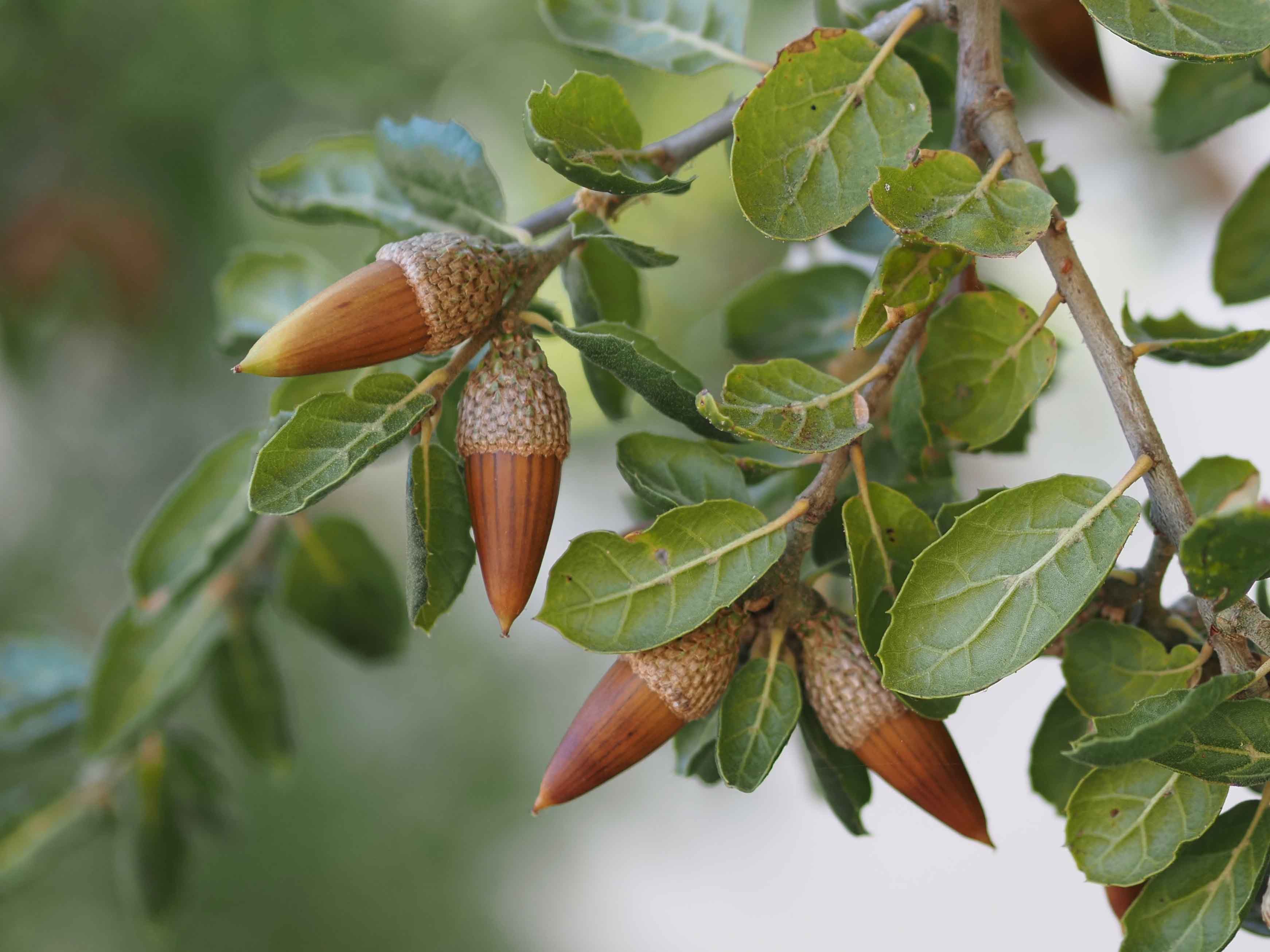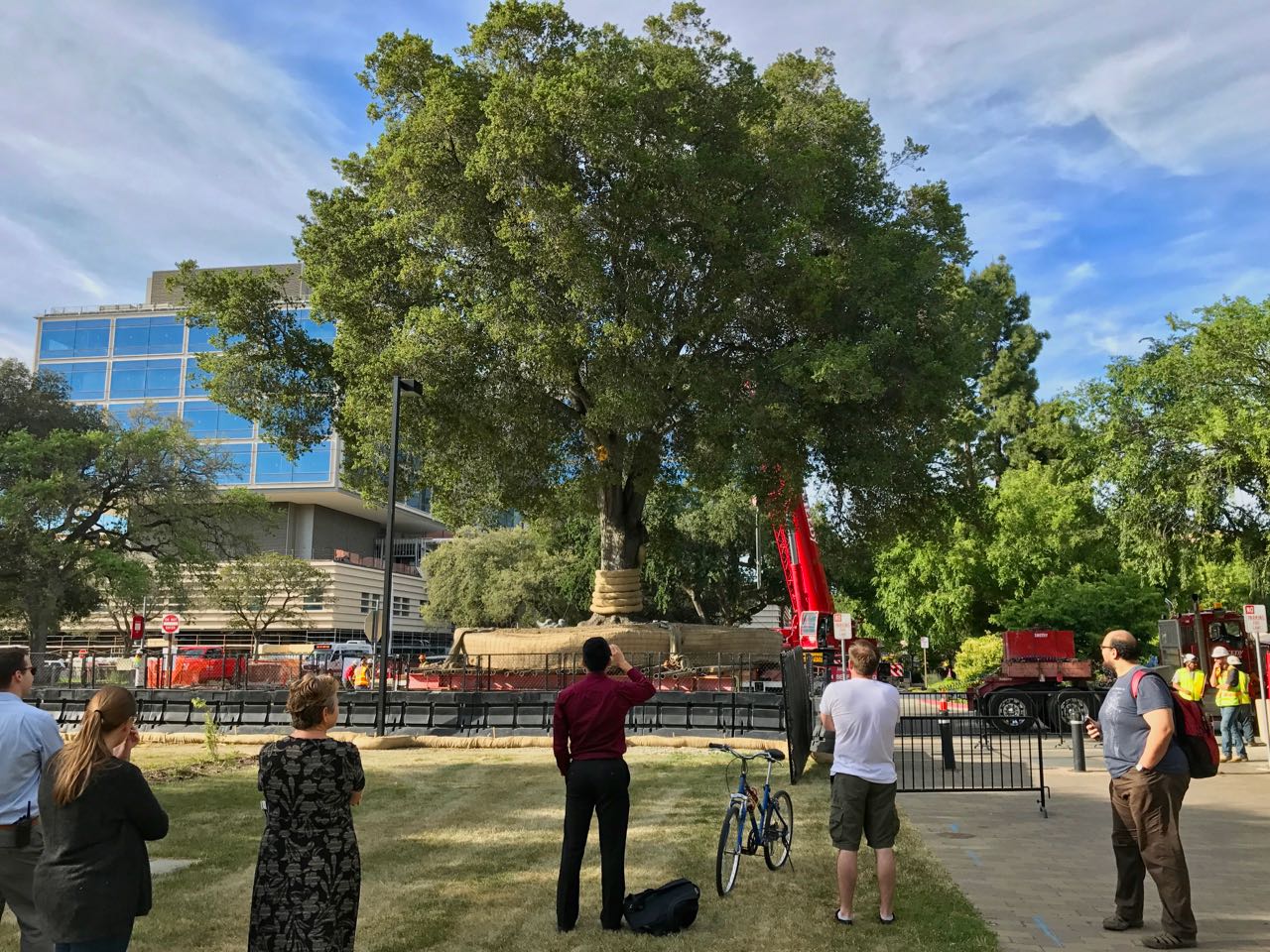Quercus agrifolia
 coast live oak, encina
coast live oak, encina

Visitors to the campus from other states often remark on the gnarled old oaks, of which magnificent specimens abound. Two species are common on campus and native to it, the evergreen live oak and the deciduous valley oak (Quercus lobata).
The word quercus means oak in Latin and survives in Italian as quercia. Agrifolia is a Medieval Latin form of aquifolium, meaning holly (the Italian word for holly is agrifoglio). Aquifolium means sharp-leaved (aqui- ultimately from acer, sharp).
The coast live oak (not to be confused with the live oak Q. virginiana of the Southern United States) has tough convex leaves 1 to 2 inches long with a few spiny teeth along the margin (the reference to holly in the name) and tufts of hair on the undersides, where the secondary veins branch from the main vein. In spring the oaks liberate great quantities of pollen from hanging catkins. The separate female flowers later produce acorns about 1½ inches long and ½ inch in diameter. Widely distributed by squirrels, and stored by woodpeckers in custom-drilled holes in tree trunks and wood siding, the acorns germinate freely all over the campus, especially where there is some ground cover.
The coast live oak is in vogue for landscaping, being perhaps the most popular single species of large tree at Stanford. It reaches an age of 200 to 300 years; an idea of the rate of growth may be gained from the row along Lasuen Mall next to the Quad, which is said to have been planted in 1918.
Significant specimens

An ancient tree on Serra Street (now Jane Stanford Way) and Lasuen Mall at the southwest corner of Lathrop Library, which was adopted by the class of 1895 as the Pioneer Oak, was Stanford’s last officially certified historic tree. It came down in 2008, but has re-grown almost to full height, sprouting from its stump.
Gone is one of the university’s most beloved specimens, which stood guard at the Mausoleum until it was removed in 1993, a victim of leaf and twig diseases cryptocline and diplodia. Estimated to be 300 years old, it measured 70 feet tall, with a trunk diameter of 55 inches and a branch spread of 120 feet. Wood from the tree was incorporated into the round table (the unusual spiral pattern) in the rotunda of Green Library’s Bing Wing.
Venerable specimens that were taken down include one in the lawn in front of Cummings Art (removed 15 December, 2010), the patriarch south of Arrillaga Alumni Center (2012), and the Gordon Hampton oak at the southwest corner of Campus Drive East and Galvez Street with the accompanying fun plaque (summer 2020). A replacement for the last, informally dubbed Gordon Hampton Junior, is thriving.
Two fine examples of Q. agrifolia grow in front of Lagunita Court. See massive specimens in the inner court of Governor’s Corner, growing there along with several valley oaks. A decades-ago fallen tree, still growing vigorously, is behind the Mausoleum.
A cabled giant at the north corner of the house at Filoli in Woodside was estimated to be 340 years old in 2018 (map pin).
Mature transplants

Seeing coast live oaks and other mature trees in large transplanting boxes around campus is commonplace. Stanford’s extensive tree transplant program originated in 1996 with the planning for the Science and Engineering Quad (Serra Grove was established on the west side of the Main Quad with transplants from that site).
In May 2017 a 550,000 pound transplant was moved just across Pasteur Drive from where it stood, to make room for the planned BioMedical Innovations Building. Alas, it did not survive crossing the road and was removed two years later.
In 2015, large oaks were removed in massive transplanting boxes in preparation for the construction of the David and Joan Traitel building on Lasuen Mall.
An example of apparent success moving a mature Q. agrifolia can be seen at Homer Park, across from 315 Homer Avenue, Palo Alto. The 35-foot-tall specimen, weighing nearly 35 tons, was transplanted to the site in August 2003.
Name derivation: See text above.
About this Entry: The main text of this entry is from the book Trees of Stanford and Environs, by Ronald Bracewell, published 2005. John Rawlings added the Cummings Art and Governor’s Corner notes in 2010. Notes on hair tufts & Traitel added, edits (Jul 2018, SP). Filoli specimen and notes on transplants added, including the Pasteur specimen (Aug 2018, SP). Alumni Center and Gordon Hampton removals noted; all locations verified (Apr 2021, SP). Specific epithet etymology corrected (Roderick Cameron provided references, starting at Née (Apr 2023, SP). Edits (Oct 2024, SP).




